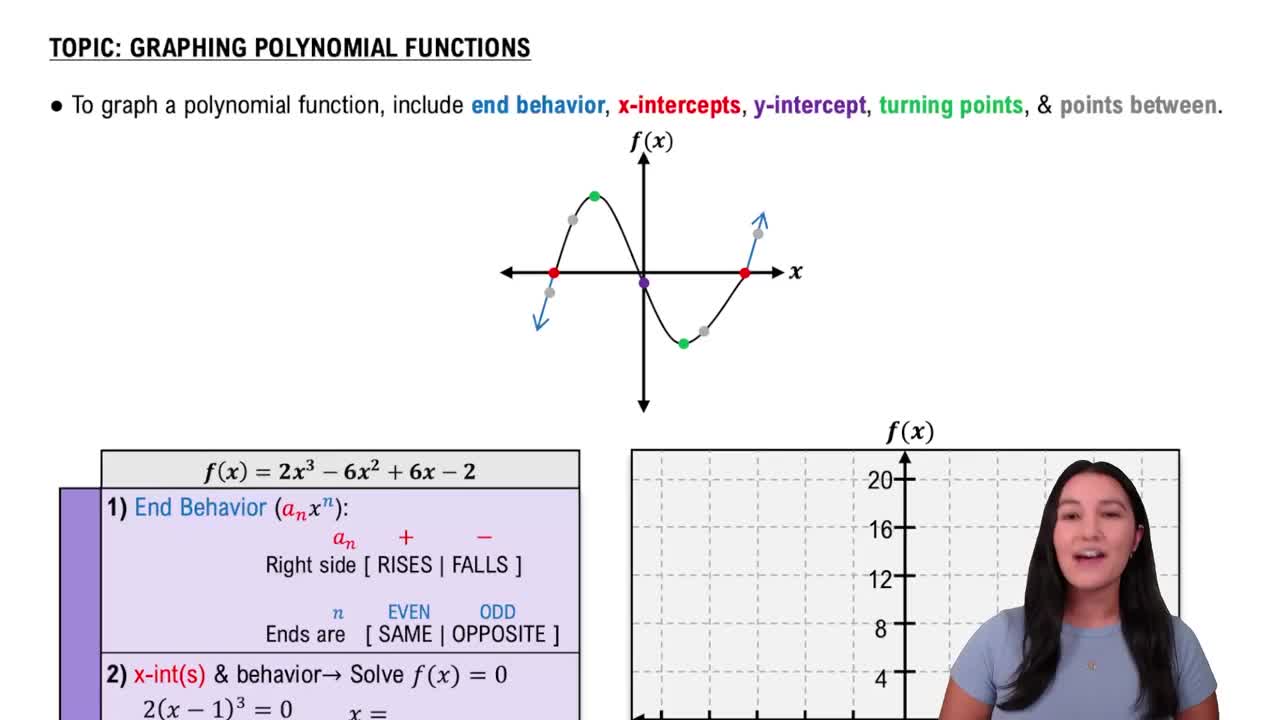Table of contents
- 0. Review of Algebra4h 16m
- 1. Equations & Inequalities3h 18m
- 2. Graphs of Equations43m
- 3. Functions2h 17m
- 4. Polynomial Functions1h 44m
- 5. Rational Functions1h 23m
- 6. Exponential & Logarithmic Functions2h 28m
- 7. Systems of Equations & Matrices4h 6m
- 8. Conic Sections2h 23m
- 9. Sequences, Series, & Induction1h 19m
- 10. Combinatorics & Probability1h 45m
4. Polynomial Functions
Zeros of Polynomial Functions
Problem 49
Textbook Question
In Exercises 39–52, find all zeros of the polynomial function or solve the given polynomial equation. Use the Rational Zero Theorem, Descartes's Rule of Signs, and possibly the graph of the polynomial function shown by a graphing utility as an aid in obtaining the first zero or the first root. 4x^4−x^3+5x^2−2x−6=0
 Verified step by step guidance
Verified step by step guidance1
Identify the polynomial: \(4x^4 - x^3 + 5x^2 - 2x - 6 = 0\).
Apply the Rational Zero Theorem to list all possible rational zeros. These are the factors of the constant term (-6) divided by the factors of the leading coefficient (4).
Use Descartes's Rule of Signs to determine the possible number of positive and negative real zeros. Count the sign changes in \(f(x)\) and \(f(-x)\).
Use a graphing utility to plot the polynomial and identify any visible zeros. This can help in choosing a candidate for synthetic division.
Perform synthetic division using one of the potential zeros to simplify the polynomial. If the remainder is zero, the candidate is a root. Repeat the process to find all zeros.
Recommended similar problem, with video answer:
 Verified Solution
Verified SolutionThis video solution was recommended by our tutors as helpful for the problem above
Video duration:
9mPlay a video:
Was this helpful?
Key Concepts
Here are the essential concepts you must grasp in order to answer the question correctly.
Rational Zero Theorem
The Rational Zero Theorem provides a method for identifying possible rational roots of a polynomial equation. It states that any rational solution, expressed as a fraction p/q, must have p as a factor of the constant term and q as a factor of the leading coefficient. This theorem helps narrow down the candidates for testing potential zeros, making it easier to find actual roots.
Recommended video:
Guided course

Rationalizing Denominators
Descartes's Rule of Signs
Descartes's Rule of Signs is a technique used to determine the number of positive and negative real roots of a polynomial function based on the number of sign changes in the polynomial's coefficients. For positive roots, count the sign changes in f(x), and for negative roots, count the sign changes in f(-x). This rule provides valuable insights into the possible number of roots, guiding further analysis.
Recommended video:
Guided course

Cramer's Rule - 2 Equations with 2 Unknowns
Graphing Polynomial Functions
Graphing polynomial functions allows for a visual representation of the function's behavior, including its zeros (x-intercepts) and overall shape. By using graphing utilities, one can identify approximate locations of roots and understand the function's increasing or decreasing intervals. This visual aid complements algebraic methods, providing a more comprehensive approach to finding and verifying the roots of the polynomial.
Recommended video:

Graphing Polynomial Functions
Related Videos
Related Practice



